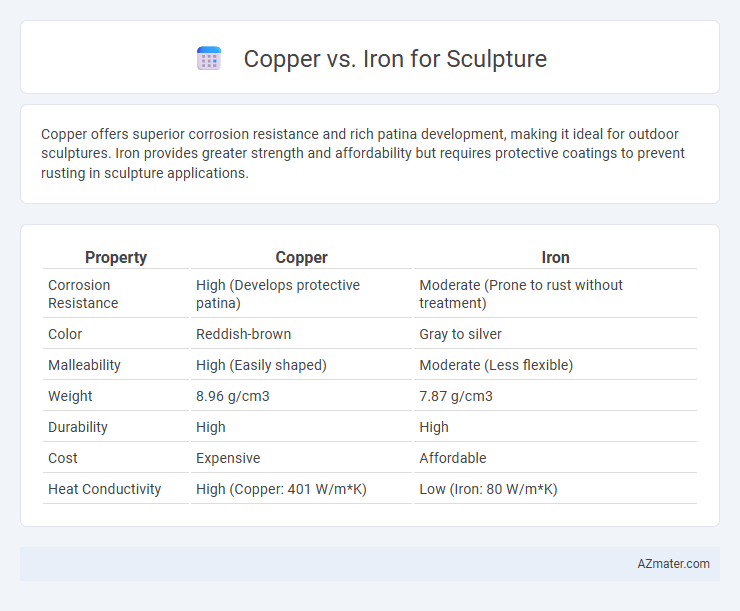Copper offers superior corrosion resistance and rich patina development, making it ideal for outdoor sculptures. Iron provides greater strength and affordability but requires protective coatings to prevent rusting in sculpture applications.
Table of Comparison
| Property | Copper | Iron |
|---|---|---|
| Corrosion Resistance | High (Develops protective patina) | Moderate (Prone to rust without treatment) |
| Color | Reddish-brown | Gray to silver |
| Malleability | High (Easily shaped) | Moderate (Less flexible) |
| Weight | 8.96 g/cm3 | 7.87 g/cm3 |
| Durability | High | High |
| Cost | Expensive | Affordable |
| Heat Conductivity | High (Copper: 401 W/m*K) | Low (Iron: 80 W/m*K) |
Introduction to Copper and Iron in Sculpture
Copper and iron are two prominent metals used in sculpture, each offering unique characteristics that influence artistic expression and structural integrity. Copper provides excellent malleability, corrosion resistance, and a distinctive warm patina that enhances its aesthetic appeal over time. Iron, known for its strength and durability, allows for large, robust sculptures but requires protective coatings to prevent rust and maintain longevity in outdoor environments.
Historical Use of Copper and Iron in Art
Copper has been favored in sculpture since ancient times due to its malleability, corrosion resistance, and warm reddish hue, prominently used by civilizations such as the Egyptians and Greeks for statues and decorative artifacts. Iron, historically less common in fine art due to its tendency to rust and brittleness, gained prominence during the Industrial Revolution when advances in metallurgy allowed for more durable and large-scale sculptures. Both metals have distinct aesthetic and structural qualities that influenced their use in different historical periods and artistic styles.
Physical Properties: Copper vs Iron
Copper offers excellent malleability and corrosion resistance, making it ideal for intricate sculptures that endure outdoor exposure. Iron, while stronger and more rigid, is prone to rust and requires protective coatings to prevent deterioration. The density of copper (8.96 g/cm3) allows for detailed work with moderate weight, whereas iron's higher tensile strength suits robust, heavy structures but compromises long-term weather resistance.
Workability and Sculpting Techniques
Copper offers superior workability for sculptors due to its malleability and ability to hold fine details, making it ideal for intricate designs and repousse techniques. Iron, while stronger and more durable, is less pliable and often requires welding or forging methods, which suit larger or more industrial-style sculptures. Sculptors favor copper when precision and detail are paramount, whereas iron is preferred for robust, structural pieces.
Durability and Longevity Comparison
Copper offers superior corrosion resistance compared to iron, making it more durable for outdoor sculptures exposed to varying weather conditions. Unlike iron, which is prone to rust and deterioration when exposed to moisture, copper forms a protective patina that stabilizes its surface over time. This natural oxidation process enhances copper's longevity, ensuring sculptures maintain structural integrity and aesthetic appeal for decades.
Aesthetic Qualities and Surface Finishes
Copper offers a warm, rich patina that evolves over time into vibrant greens and blues, enhancing the sculpture's visual depth and character. Iron provides a more industrial, rugged aesthetic with dark, matte tones that can develop rust, adding raw texture and an aged appearance. Both metals respond uniquely to surface treatments: copper accepts polished, brushed, or verdigris finishes, while iron benefits from powder coating, patination, or controlled oxidation for varied protective and visual effects.
Weather Resistance and Corrosion Factors
Copper offers superior weather resistance compared to iron due to its ability to develop a stable patina that protects the underlying metal from corrosion. Iron, especially when unprotected, is prone to rusting quickly in outdoor environments as it reacts with moisture and oxygen, compromising its structural integrity. Copper's natural corrosion resistance and longevity make it a preferred choice for sculptures exposed to harsh weather conditions.
Cost and Availability of Materials
Copper sculpture materials are generally more expensive than iron due to higher raw material costs and greater demand in electrical and decorative industries. Iron is widely available and more affordable, making it a popular choice for large-scale or budget-conscious projects. The cost-effectiveness of iron often outweighs copper despite copper's superior corrosion resistance and aesthetic appeal.
Sustainable and Environmental Impacts
Copper offers superior sustainability for sculpture due to its high recyclability and lower extraction impact compared to iron, reducing environmental degradation and energy consumption during production. Iron mining generates more greenhouse gases and often results in significant habitat disruption, making copper a more environmentally responsible choice for artists prioritizing ecological concerns. Both metals can be recycled, but copper's ability to retain quality through multiple recycling processes positions it as a greener option for long-term sculptural use.
Choosing the Right Metal for Your Sculpture
Copper offers excellent malleability and develops a distinctive green patina over time, enhancing its aesthetic appeal in sculptures. Iron provides superior strength and durability but requires protective coatings to prevent rust and corrosion in outdoor installations. Choosing between copper and iron depends on the sculpture's intended environment, desired finish, and long-term maintenance considerations.

Infographic: Copper vs Iron for Sculpture
 azmater.com
azmater.com